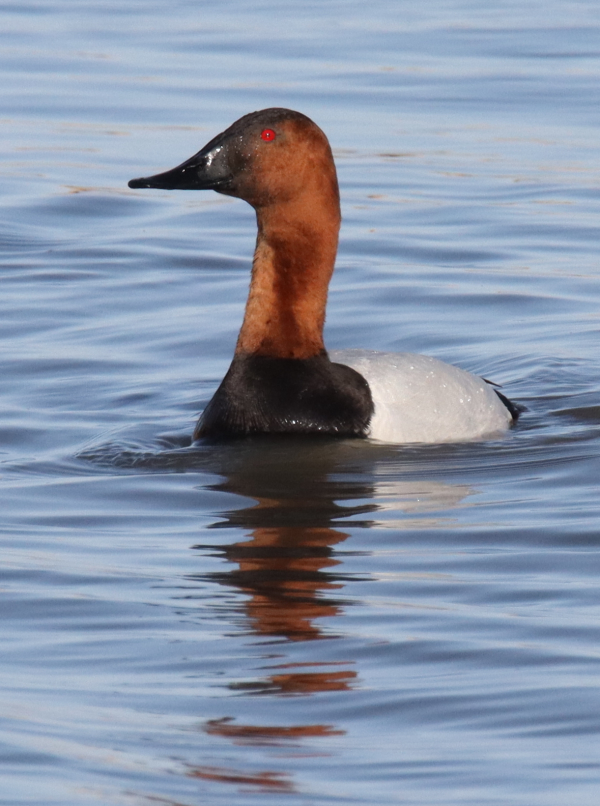
A regal-looking drake Canvasback provided a fine portrait in the midst of especially beautiful calm blue water. Canvasbacks and 14 other species of ducks now fill marshes and lakes surrounding The Birding Wire office.
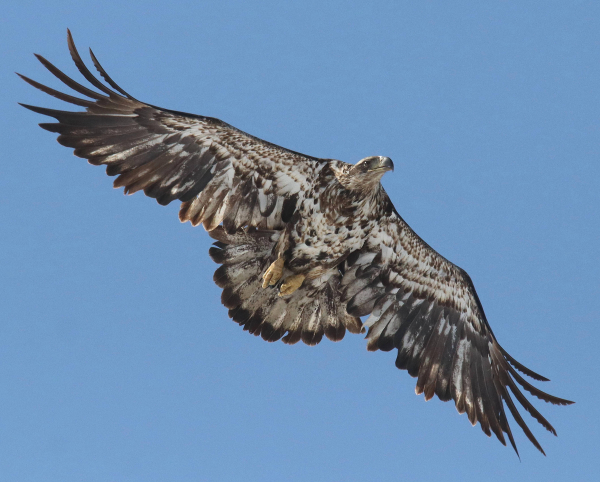
A fully spread second-year Bald Eagle was photographed as it winged overhead during an ‘eagle parade,’ creating a thrilling image aided by morning sunlight.

Ross’s Geese are noticeably more common among the new flocks of Snow Geese making a stopover. The top 2 birds are Snow Geese, while the others can be distinguished as Ross’s Geese by their smaller size overall, especially their head and bill.
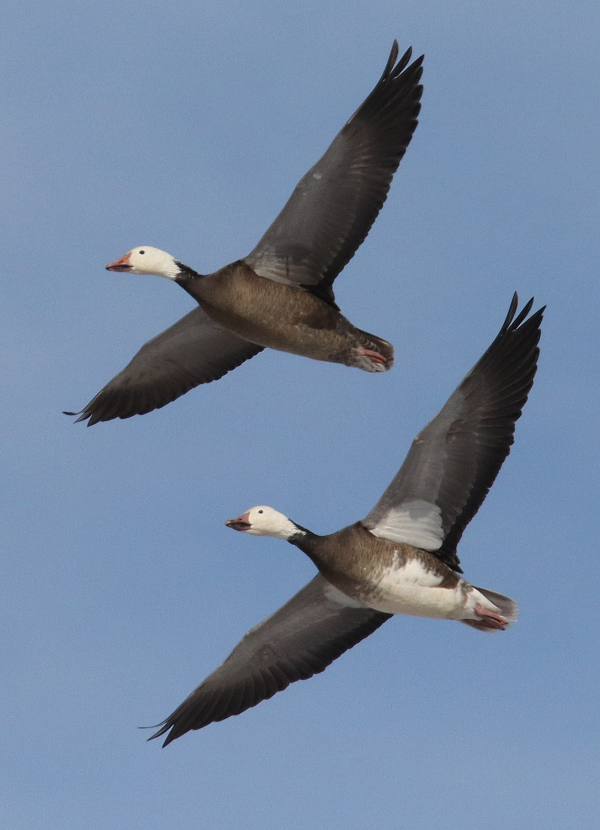
Keeping with the Snow Goose theme, these blue morph Snows provide dramatically different colors when mixed in the predominantly white morph flocks. Note that the lower goose shows a white belly and underwing feathers that indicates some hybrid blue-white linage.
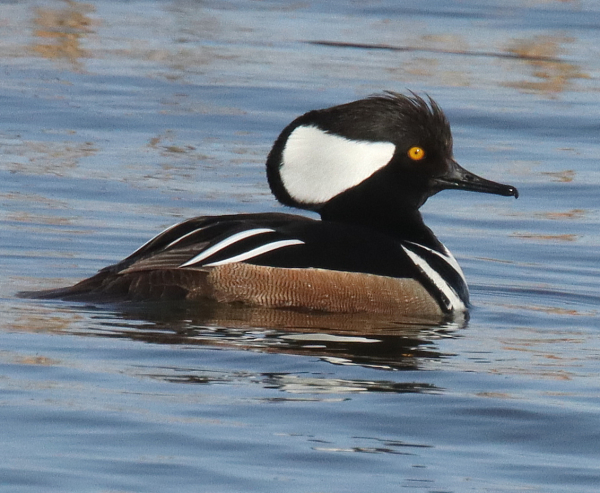
Always fun to see in area wetlands, a drake Hooded Merganser shows its head crest in a partly excited, partly relaxed position.
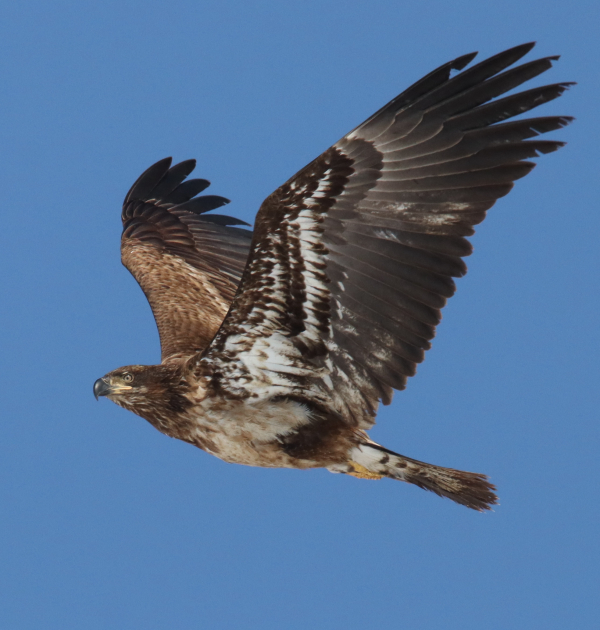
A return to the borderlands marshes provided improved photo opportunities with a minimum of 198 Bald Eagles in the area. The eye of this eagle is especially sharp, which follows through to the rest of its features and plumage – and that’s emphasized in the cropped enlargement of this photo below.
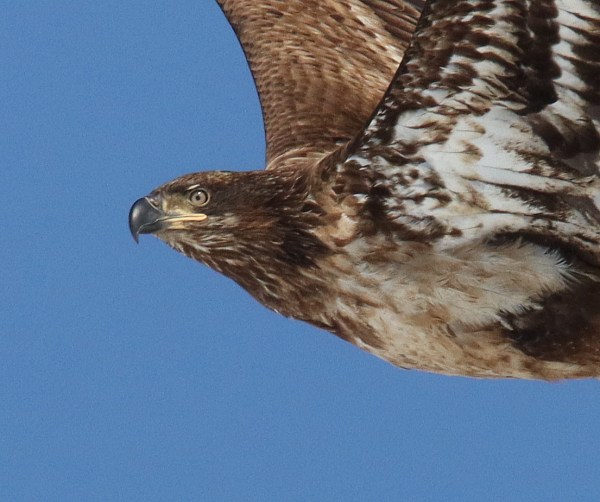
|
A cruel April Fools snowstorm dominated last week’s birding and birds in the Northern Plains, but in my area it seemed to bring new birds into the local realm – a migration renewal of sorts – with flocks of 5 species of geese and a nice variety of 15 species of ducks on hand now, as new birds appeared: a Brown Creeper, Belted Kingfisher, pairs of Blue-winged Teal, a pair of Ruddy Ducks, a lone Pied-billed Grebe, and 6 Mourning Doves with more Ring-necked Ducks and Ross’s Geese than I’ve seen here before. Geese dominated the area by the numbers, although in flocks of hundreds rather than thousands as before, and displaying ducks in search of mates included Canvasbacks, Hooded Mergansers, Lesser Scaup, Ring-necked Ducks, and Redheads.
Another interesting addition to the area was large flocks of Lapland Longspurs, numbering 20 to 50, more or less. I counted 9 such flocks of longspurs along a 4-mile drive north as an example of the birds on hand. Many males were almost fully colored in their alternate plumage, and the flocks are reminiscent of the Snow Buntings that arrived during the coldest period of February – the coldest days of the year. Like the buntings, the longspurs were only on hand a short time, a few days, and they were gone. Flocks of other birds continued to appear too, including Western Meadowlarks, Common Grackles, and Red-winged Blackbirds.
198 Bald Eagles! Ten days after counting 618 Bald Eagles in the borderlands area near Hecla, South Dakota, I attempted another count of the national bird in that area as I watched for primo photo opportunities. In the borderlands area of North Dakota I counted 96 eagles, 4 miles north of Hecla Marsh, and at the marsh there were another 17 Bald Eagles, with 95 more eagles 3 miles south – a minimum of 198 Bald Eagles! While that total was about 1/3 the number I observed 10 days earlier, the number of eagles I was able to photograph was much better, as were the resulting images of eagles ranging from yearlings to adult pairs.
At a favorite photo site in that area, an almost non-stop parade of from 1 to 4 eagles at a time flew before me as I focused on individuals and pairs during more than a half-hour of photo fun. As they winged forward, circled, and even landed, the eagles provided fast-paced photo action, which made me think: “Oh what fun it is to be an eagle photographer!” I go into more details in this week’s Bird Photography feature that also has more photographs presented on a larger format.
During a local Sunday afternoon birding drive, I observed 5 large groups of Snow and Ross’s Geese with White-fronted Geese in the mix. Cackling Geese were rare, and Giant Canada Geese were scattered into pairs across the area. There were also 8 Tundra Swans at 1 marsh and pairs of swans at 2 other wetlands. There were 4 Red-tailed Hawks, including 1 dark-morph Harlan’s Red-tailed Hawk, and 3 Bald Eagles, all in separate areas. Northern Harriers were widely scattered, mostly males, along with an occasional American Kestrel. A variety of ducks were evident on every marsh and lake, and it’s especially fun to try to photograph their mating displays, as well as to watch the varied behaviors performed by different species. A dozen White Pelicans was on hand too, along with a few scattered Double-crested Cormorants, while very widely scattered Greater Yellowlegs and Killdeer were on hand too.
It’s clear that things are changing rapidly after the snowy hiccup last week, and by Monday afternoon geese were hard to find – only present at Dean’s Lake a mile northwest of my office. As I began my Monday drive, only a mile south I spied a Bald Eagle in the distance. As I drove closer a second eagle dived down to meet it in flight, initiating a chase that took them barreling across the road in front of me, and that’s when they were joined by a third eagle, then a fourth!
The 4 immature eagles settled into a small tree grove 2 miles south of my office where they were surprisingly quite vocal; and they were quickly joined by 2 more single eagles that flew in from opposite directions. A half-mile farther south another eagle was perched on a snag that reached above an unnamed lake with many Common Goldeneye pairs watching from the surface. Later, I found 6 more Bald Eagles perched in 2 different trees 4 miles north of my office, making a total of 13 eagles with the 2 groups separated by just 6 miles.
Duck numbers varied widely on different wetlands compared to the previous 3 afternoons too. Yes, birds are anything but predictable, and even the number of American Robins were obviously more abundant as they were actively pulling the first earthworms out of the ground this spring. As this unusual week draws to a close, it was surely a memorable one with an abundance of migratory birds on hand, with new species appearing, and others moving on. Isn’t early spring great fun to witness? Try to get yourself in the middle of a migration event, or a concentration of birds during a migration stopover – it will surely be a refreshing experience with the sights and sounds of birds slicing the fresh air of early spring; Enjoy!
Article and Photos by Paul Konrad
Share your bird sightings and photographs at editorstbw2@gmail.com